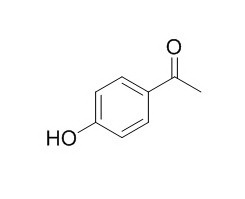4'-Hydroxyacetophenone
4'-Hydroxyacetophenone is a potent xanthine oxidase inhibitor, three 4′-hydroxyacetophenone-related phytoalexins from Polymnia sonchifolia have antifungal activity.
Inquire / Order:
manager@chemfaces.com
Technical Inquiries:
service@chemfaces.com
Tel:
+86-27-84237783
Fax:
+86-27-84254680
Address:
1 Building, No. 83, CheCheng Rd., Wuhan Economic and Technological Development Zone, Wuhan, Hubei 430056, PRC
Providing storage is as stated on the product vial and the vial is kept tightly sealed, the product can be stored for up to
24 months(2-8C).
Wherever possible, you should prepare and use solutions on the same day. However, if you need to make up stock solutions in advance, we recommend that you store the solution as aliquots in tightly sealed vials at -20C. Generally, these will be useable for up to two weeks. Before use, and prior to opening the vial we recommend that you allow your product to equilibrate to room temperature for at least 1 hour.
Need more advice on solubility, usage and handling? Please email to: service@chemfaces.com
The packaging of the product may have turned upside down during transportation, resulting in the natural compounds adhering to the neck or cap of the vial. take the vial out of its packaging and gently shake to let the compounds fall to the bottom of the vial. for liquid products, centrifuge at 200-500 RPM to gather the liquid at the bottom of the vial. try to avoid loss or contamination during handling.
Exp Ther Med.2019, 18(6):4388-4396
Food Res Int.2020, 133:109130.
Molecules.2019, 24(9):E1719
Food Chem.2022, 378:131975.
J Sci Food Agric.2018, 98(3):1153-1161
Redox Biology2024, 103197.
Chem Biol Interact.2019, 315:108910
Int J Biol Macromol.2021, 199:189-200.
Environ Toxicol.2024, 39(4):2417-2428.
PLoS One.2017, 12(3):e0173585
Related and Featured Products
J Agric Food Chem. 2014 Apr 30;62(17):3742-9.
Inhibition of xanthine oxidase by Rhodiola crenulata extracts and their phytochemicals.[Pubmed:
24712453]
Using a fractionation technique, four phytochemicals were isolated from Rhodiola crenulata extracts. These compounds were identified as 4'-Hydroxyacetophenone (4-HAP), epicatechin-(4β,8)-epicatechin gallate (B2-3'-O-gallate), salidroside, and p-tyrosol using mass spectrometry and nuclear magnetic resonance spectroscopy.
METHODS AND RESULTS:
The inhibition of xanthine oxidase (XO) activity by these purified compounds was then evaluated and compared to that of a known XO inhibitor (allopurinol; IC50 = 12.21 ± 0.27 μM). Both 4'-Hydroxyacetophenone and B2-3'-O-gallate showed an XO inhibitory effect, for which the half maximal inhibitory concentration (IC50) values were 15.62 ± 1.19 and 24.24 ± 1.80 μM, respectively. However, salidroside and p-tyrosol did not show significant inhibitory effects on XO at 30 μM. Furthermore, an inhibition kinetics study indicated that 4'-Hydroxyacetophenone and B2-3'-O-gallate are mixed competitive inhibitors. The inhibition constants (Ki) of 4'-Hydroxyacetophenone and B2-3'-O-gallate were 8.41 ± 1.03 and 6.16 ± 1.56 μM, respectively.
CONCLUSIONS:
These results suggest that 4'-Hydroxyacetophenone and B2-3'-O-gallate are potent XO inhibitors.
J Phys Chem A. 2014 Sep 18;118(37):8170-6.
Controlling dissociation of alkyl phenyl ketone radical cations in the strong-field regime through hydroxyl substitution position.[Pubmed:
24576102 ]
METHODS AND RESULTS:
The hydroxy-substituted alkyl phenyl ketones 2'-, 3'- and 4'- (ortho, meta, and para) hydroxyacetophenone were excited in the strong-field regime with wavelengths ranging from 1200-1500 nm to produce the respective radical cations.
For 2'- and 3'-hydroxyacetophenone, the parent molecular ion dominated the mass spectrum, and the intensity of the fragment ions remained unchanged as a function of excitation wavelength. In contrast, 4'-Hydroxyacetophenone exhibited depletion of the parent molecular ion with corresponding enhanced formation of the benzoyl fragment ion upon excitation with 1370 nm as compared with other excitation wavelengths. Density functional (DFT) calculations suggest that dissociation occurs when the acetyl group in 4'-Hydroxyacetophenone radical cation twists out-of-plane with respect to the phenyl ring, enabling a one-photon transition between the ground cation state D0 and the excited cation state D2 to occur. The DFT calculations also suggest that the lack of dissociation in the wavelength-resolved strong-field excitation measurements for 2'- and 3'-hydroxyacetophenone arises because both isomers have a barrier to rotation about the carbon-carbon bond connecting the phenyl and acetyl groups.
CONCLUSIONS:
These results help elucidate the effects of substituents on the torsional motion of radical cations and illustrate the potential for controlling molecular dissociation through the addition of substituents.
Phytochemistry, 1996, 43(5):1019-21.
Three 4′-hydroxyacetophenone-related phytoalexins from Polymnia sonchifolia.[Reference:
WebLink]
Inoculation of sliced yacon tubers with Pseudomonas cichorii resulted in the formation of antifungal compounds. Three major phytoalexins were isolated and identified by spectroscopic methods as 4′-hydroxy-3′-(3-methylbutanoyl)acetophenone, 4′-hydroxy-3′-(3-methyl-2-butenyl)acetophenone and 5-acetyl-2-(1-hydroxy-1-methylethyl)benzofuran.



